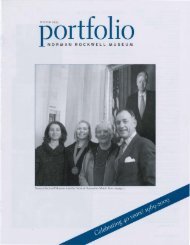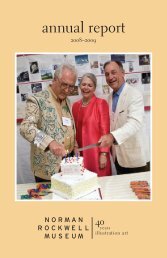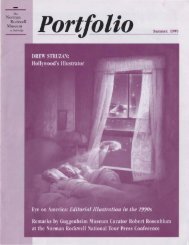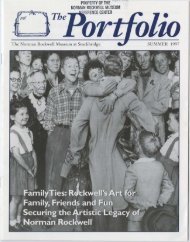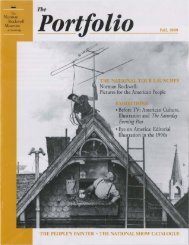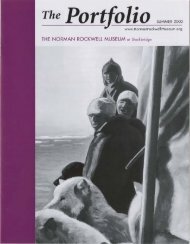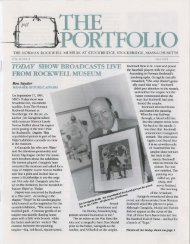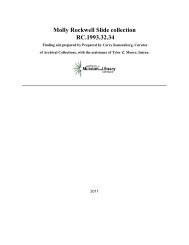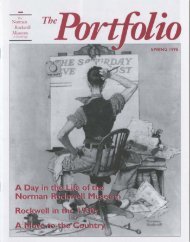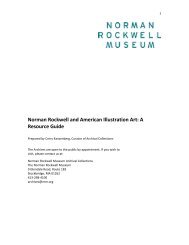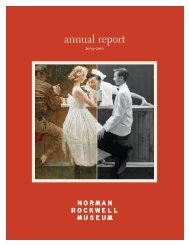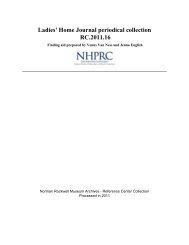Summer 2009 - Norman Rockwell Museum
Summer 2009 - Norman Rockwell Museum
Summer 2009 - Norman Rockwell Museum
- No tags were found...
Create successful ePaper yourself
Turn your PDF publications into a flip-book with our unique Google optimized e-Paper software.
<strong>Rockwell</strong>’s Legacy“If we lose what it is that <strong>Rockwell</strong>’s art stood for, thenwe have lost something very basic to what it means tobe an American.”Robert A.M. Stern, architect of the <strong>Museum</strong>Golden Rule, 196140th anniversary portfolio 5
Stories in picturesClockwise from top left: Girl Reading the Post, 1941; New Kids in the Neighborhood, 1967; Mine America’s Coal, 1944; Lincoln for the Defense, 1961; Artist Facing Blank Canvas (The Deadline), 1938;Age, artists were in high demand. In book and magazine cover art,as in story illustrations meant to illuminate an author’s text, narrativeimagery reigned supreme even as the world of fine art began toreject it. While illustrators and painters explored similar motifs suchas the portrayal of scenes from everyday life, illustration emphasizedaccuracy, technical virtuosity, and anecdote rather than thenotion of personal expression. Richly visual, America’s leadingpublications relied upon the abilities of gifted illustrators to engagethe attention and emotions of their readers. Their ingenious, oftenidealized images portrayed the best in us, persuading us to believein ourselves, and especially, in whom we might become.In today’s digital information age, it is difficult to imagine therole that magazines played in a society quite different from our own,in which radio and telephone offered the only technological connectionbetween home and the larger world. Ephemeral by designand available at low cost, leading weeklies and monthlies like TheSaturday Evening Post, Ladies’ Home Journal, Good Housekeeping,McCall’s, and Woman’s Home Companion provided a steady streamof information, entertainment, and advice to vast, loyal audiences.While top publications boasted subscriptions of two to eight millionduring the 194os and 195os, anxiously awaited journals were sharedamong family and friends, bringing readership even higher. Fictionand serialized novels; poetry; articles on politics, fashion, andbeauty; and guidance on marriage, child rearing, and householdmanagement were staples, second only to the array of advertisementsand product enticements that supported the bottom line andoccupied the most space in each issue.By the American mid-century, photography captured themoment for many publications that were striving to remain current,and dramatic shifts in magazine content prompted the movementaway from narrative illustration to conceptual or decorative forms.Fiction, which had previously played a central role in magazines,was sidelined by a plethora of non-fiction articles that inspired amore abstract, symbolic approach to image-making. Colorful, personal,and extremely varied in style, these artworks balanced thespecificity of the photographic image in publishing, and attemptedto blur the lines between fine and applied art.Despite a consensus that narrative illustration faltered becausethe advent of photography and shifts in content reduced theneed for naturalistic pictures, this important American art form8 www.nrm.org
Forty years of scholarship<strong>Norman</strong> <strong>Rockwell</strong> <strong>Museum</strong> began its commitmentto scholarship early in its history, with thedevelopment of <strong>Rockwell</strong>’s catalogue raisonné.This massive undertaking resulted in a twovolumecompendium of the artist’s nearly 4,000known paintings and drawings, which has servedas the foundation for all subsequent <strong>Rockwell</strong>research. Since then, the <strong>Museum</strong> has explored<strong>Norman</strong> <strong>Rockwell</strong> and the art of illustration in100 exhibitions showcasing over 420 artists, aswell as through significant original scholarship. Innumerous exhibition catalogues, the <strong>Museum</strong> haspresented its own scholarship and invited criticalexamination of <strong>Rockwell</strong> and other illustratorsby art historians and visual studies scholarsnationwide. The <strong>Museum</strong>’s publications include:The Illustrator’s Moment, 1978American Family Life: The Massachusetts Mutual LifeInsurance Drawings, 1980<strong>Norman</strong> <strong>Rockwell</strong>: A Definitive Catalogue, 1986<strong>Norman</strong> <strong>Rockwell</strong>: A Centennial Celebration, 1994<strong>Norman</strong> <strong>Rockwell</strong>:Pictures for the American People, 1999Distant Shores: The Odyssey of <strong>Rockwell</strong> Kent, 2001The Art of the Postage Stamp, 2003Aunt Ella Takes a Trip, 1942; Strictly a Sharpshooter, 1941has always been about more than just the appearance of things.Through the decades, this art of mass culture has looked deeplyinto society, reflecting and shaping a rapidly changing world.Though periodicals have made way for new media, the impact ofnarrative imagery continues to be felt. In the digital age, contemporaryaudiences are as happy as their predecessors to suspend disbeliefin the face of visual technology, which now has the power tobring the impossible to life.Today, on the 4oth anniversary of the <strong>Museum</strong> that was trulybuilt by popular demand, <strong>Norman</strong> <strong>Rockwell</strong>’s belief in the abilityof images to speak about and to humanity remains at the coreof the <strong>Museum</strong>’s mission. Through the years, <strong>Norman</strong> <strong>Rockwell</strong><strong>Museum</strong> has inspired millions to view the art of mass culture withfresh eyes. We look forward to our continued work in the vanguardof preservation, interpretation, and scholarship relating tothe art of <strong>Norman</strong> <strong>Rockwell</strong> and the art of illustration for manyyears to come.Fred Marcellino:Dancing by the Light of the Moon, 2005Frederic Remington:The American Civil War, A Ghost Story, 2006Ephemeral Beauty: Al Parker and the AmericanWomen’s Magazine, 1940-1960, 2007American Chronicles:The Art of <strong>Norman</strong> <strong>Rockwell</strong>, 2007The Fantastical Faces of Peter <strong>Rockwell</strong>, <strong>2009</strong>Stephanie Haboush Plunkett is Chief Curator and Deputy Directorof <strong>Norman</strong> <strong>Rockwell</strong> <strong>Museum</strong>. She is a national authority on illustration art.40th anniversary portfolio 9
“The best of America”At home in Stockbridgeby Linda Szekely Pero“I just love Stockbridge. I mean, Stockbridge is the best of America, the best of New England.”<strong>Norman</strong> <strong>Rockwell</strong>In 1953, <strong>Norman</strong> <strong>Rockwell</strong> and his wifeMary relocated from Arlington, Vermont, toStockbridge, Massachusetts. The small townof 2,100 people provided new faces andnew inspirations for such pictures as FamilyTree, which traced the lineage of the “all-American boy” from a sixteenth centurypirateand his Spanish princess captured onthe Caribbean Sea. In progress were someof his most memorable paintings—Girl atMirror, Breaking Home Ties, and Choir Boy—and, as always, deadlines loomed.By all accounts, <strong>Rockwell</strong> had loved hislife in Arlington, but he never looked back.He welcomed the fresh assortment of facesfor his pictures and the new social opportunities.He joined in community activitiesthat were different from his former Grangeexperience in Vermont. Now he gatheredweekly at the Red Lion Inn with friendsin the Marching and Chowder Society todiscuss current events over lunch. Moreformal were his monthly meetings of theMonday Evening Club, a group of prominentBerkshire County citizens.Though the gregarious <strong>Rockwell</strong> on onehand enjoyed having a studio in the centerof town where he could view prospectivemodels from his large second floor picturewindow, he was accustomed to having amuch larger space laid out in the familiarmanner of his former custom-built studiosin New Rochelle and Arlington. Meanwhile,for Mary, the view of the cemetery fromtheir kitchen window was an ominous landscape.In 1957, they bought an eighteenthcenturyhome near the center of town, andthat summer they converted its carriagebarn into a studio. <strong>Rockwell</strong> welcomed newfriends and neighbors into the studio. Heinvited schoolchildren from nearby PlainSchool to hear him talk about art, and later,when the Old Corner House museum wasestablished, docents came to gain insightabout his process.Just as he had in New Rochelle andArlington, <strong>Rockwell</strong> contributed often tolocal projects. For the anniversary of thetown’s library, he created a fund driveposter. When the women of St. Paul’sEpiscopal Church published a fundraisingcookbook, he sketched a jaunty lookingchef for their cover. And for the dedicationceremony of the new post office,<strong>Rockwell</strong> sketched mailman Tom Caryfor the program cover. The most amazingtribute to his town, because <strong>Rockwell</strong> wasleast of all a painter of landscapes, was aneight-foot-long painting of the town’s MainStreet, published by McCall’s to celebrateChristmas in small-town America.During his later Stockbridge years,<strong>Rockwell</strong> produced paintings that willalways resonate. The Problem We All LiveWith gently presents an aggressive assertionof moral decency. Art critics, connoisseurs,and historians continue to examineand reflect on The Connoisseur as theydiscuss “high” and “low” art and the meaningsof abstract art. Art Critic will alwaysintrigue for its masterly technique andthe delight we feel as we are drawn intoits secret life. For five decades, <strong>Rockwell</strong>opened our hearts by lovingly portrayingour foibles. When he shifted his attentionto the broader picture of social ills,he faced an audience ready to receive hismessages, helping us evolve into a morecompassionate culture.Despite declining health, <strong>Rockwell</strong>accepted a commission to paint the July1976 cover of American Art magazine, celebratingthe country’s bicentennial. Thatsummer, in a parade and celebration, thepeople of Stockbridge claimed <strong>Rockwell</strong> astheir hometown hero. In 1978, at age 84,<strong>Rockwell</strong> died at home.Linda Szekely Pero is Curator Emerita at<strong>Norman</strong> <strong>Rockwell</strong> <strong>Museum</strong>. She retired in 2008after 25 years of service. This piece is excerptedfrom American Chronicles: The Art of <strong>Norman</strong><strong>Rockwell</strong> by Linda Szekely Pero. © 2007 by<strong>Norman</strong> <strong>Rockwell</strong> <strong>Museum</strong>, Stockbridge, Mass.10 www.nrm.org
<strong>Rockwell</strong>’smodels<strong>Rockwell</strong> recruited hisStockbridge neighbors asmodels, posing them forthe carefully composedphotographs that informedhis paintings. Many of<strong>Rockwell</strong>’s models remainconnected to the <strong>Museum</strong>,delighting visitors withtheir memories and stories.40th anniversary portfolio 11
A time for transition<strong>Norman</strong> <strong>Rockwell</strong> and the 196osby Corry KanzenbergIn celebration of its 40th anniversary, <strong>Norman</strong> <strong>Rockwell</strong> <strong>Museum</strong>unveiled its first reinstallation of <strong>Rockwell</strong>’s Stockbridge studiothis spring, giving visitors a glimpse into the artist’s workspace asit appeared in the fall of 1960. At the time, <strong>Rockwell</strong> was busycompleting his painting Golden Rule.For <strong>Norman</strong> <strong>Rockwell</strong>, 1960 marked the beginning of a decade ofchange. In August of the previous year, Mary Barstow <strong>Rockwell</strong>,his wife of 28 years and the mother of his children, unexpectedlypassed away after a long struggle with depression. Over thenext few years, tensions would arise between <strong>Rockwell</strong> and theSaturday Evening Post, ultimately ending his production of originalwork for the magazine. And in a seemingly improbable shift,complex subjects of topical significance became the focus of many<strong>Rockwell</strong> artworks.After the devastating loss of Mary, <strong>Rockwell</strong> retained his compulsiveneed to work. Meeting his obligations to the Post, Doubleday,and others diverted some of his grief, as did the debut of his autobiography,<strong>Norman</strong> <strong>Rockwell</strong>: My Adventures as an Illustrator, inbookstores on February 13, 1960. <strong>Rockwell</strong> was enthusiastic aboutthe book’s release, saying, “You can imagine—here I am an old soand so, next year is my 45th year doing Post covers, and this is like, Idon’t know, just wonderful.”That July, reconsidering an abandoned 1952 concept, <strong>Rockwell</strong>pulled out his six-foot-long drawing, United Nations, from thestudio basement. United Nations depicted the Security Councilin session, with, as <strong>Rockwell</strong> put it, “behind them the peoples ofthe world, for whom the deliberations of the Council mean peaceor war, the chance to live their lives in happiness or in misery.”He used that grouping of people as the basis for Golden Rule, hispainting for the April 1, 1961 Saturday Evening Post cover.<strong>Rockwell</strong>’s inspiration for the painting stemmed from theuniversally held principle of the Golden Rule, “Do Unto OthersAs You Would Have Them Do Unto You.” He hired a local artistto letter the adage onto the completed canvas. The painting,on which <strong>Rockwell</strong> spent nearly five months, predated his boldersocially conscious pictures, but it suggested <strong>Rockwell</strong>’s growingdesire to promote issues of equality through his artwork. Writingabout Golden Rule, he noted, “Most of the time I try to entertainwith my Post covers. But once in a while I get an uncontrollableUnited Nations, 195312 www.nrm.org
urge to say something serious.” That same urge would soon abethis decision to end his work for the Saturday Evening Post.In 1961, two years after Mary’s death, <strong>Rockwell</strong> married MollyPunderson, a retired schoolteacher. Outspoken in her liberalpolitical beliefs, she spurred <strong>Rockwell</strong>’s interest in broadeninghis subject matter. That same year, there was a staff shakeup atthe Post. Ben Hibbs, the magazine’s editor-in-chief of 20 years,resigned, soon followed by <strong>Rockwell</strong>’s longtime art editor, KenStuart. After Hibbs, the publication went through several editors,and its eventual new regime implemented change and staff cutsacross the board. As its advertising revenues were lost to television,the Post broke with all its major cover illustrators by the endof 1962, replacing them with less costly photographers. <strong>Rockwell</strong>himself was commissioned to complete portraiture for the coversrather than the narratives he so loved.In the end, a combination of proceedings prompted histough decision to break ties with the Post. Compensation was onefactor. For many of the new cover portraits—called “quickies” bythe staff—<strong>Rockwell</strong> was paid $2,000 rather than his usual $5,000.The Post had also proposed that he illustrate the Bible, whichhe was opposed to doing. <strong>Rockwell</strong>’s September 9, 1963 letter ofresignation read, “I have come to the conviction that the work Inow want to do no longer fits into the Post scheme. I am beyondthe age of retirement, and only have a few years left to do illustrations.I don’t want to retire, but I want to have freedom to do thework I wish. A project as large as the Bible would allow me notime for several years to do the other things when, where, and asI wish.” At the time of his letter, <strong>Rockwell</strong> was already workingout a deal with Look magazine.<strong>Rockwell</strong> met with Look’s directors in August of 1963 to discussthe possibility of working for the publication. They offered him theliberty to depict subjects most meaningful to him, and once histenure with the Post officially ended, he set to work on his first Lookcommission. It was a large oil painting that dealt with the issue ofschool desegregation, titled The Problem We All Live With, and waspublished as a two-page spread inside the January 14, 1964 issue.He lightly explained to a fan of the piece, “I just had my seventiethbirthday and am trying to be a bit more adult in my work.” <strong>Rockwell</strong>had long been a supporter of the civil rights movement, and thepainting marked the beginning of a new era in his art.<strong>Rockwell</strong> in his Stockbridge studio painting Golden Rule, 1960 The Problem We All Live With, 196340th anniversary portfolio 13
A time for transitionUntil the publication stopped printing in 1971, <strong>Rockwell</strong> producedart for Look that dealt with contemporary subjects, not onlycivil rights, but also the Peace Corps, the need for governmenttransparency, and the space race. He completed six illustrationson the topic of space exploration, which put him at the forefrontof the national excitement surrounding the program. He laterrecalled of the space program, “It pulled America together. Therewas a terrific pro-America feeling among Americans when themoon-landing project was on.”Outside of Look, he accepted other commissions thatreflected the culture of the times and his willingness to embraceit. In 1968, the musician Al Kooper approached a CBS art directorwith the idea of having <strong>Rockwell</strong> paint him and MichaelBloomfield for the cover of their forthcoming album, The LiveAdventures of Mike Bloomfield and Al Kooper. Accepting thejob, <strong>Rockwell</strong> went to New York to meet the musicians and havethem photographed for the portrait. Years later, Kooper remembered<strong>Rockwell</strong>’s kindness, including the fact that <strong>Rockwell</strong>invited both musicians to his exhibition opening at BernardDanenberg Galleries in New York City in 1972. Kooper recalledstanding out at the show, “dressed in satin pants, Nehru shirt,two-thousand-bead necklaces,” but noted that when <strong>Rockwell</strong>arrived, he came straight over, hugging Kooper before greetinganyone else.<strong>Rockwell</strong>’s timely work of the 1960s (the penultimate decadeof his career) remained highly important to his self-perceptionuntil the end of his life, yet he accepted the nostalgic sentimentthe public felt for his earlier pictures. In 1972, hinting athis frustration with the government and the Vietnam War, heremarked, “Now that America is in trouble so much, people goback to those things I painted when we had a stronger belief inourselves.” Indeed, the ability of <strong>Rockwell</strong>’s art to evoke bygonetimes is one of the many reasons it is still so widely enjoyed. Yetthe work he produced during the 1960s stands out, as testamentto a major change in what <strong>Rockwell</strong> sought to accomplish withhis art and as witness to our nation’s history through one of itsmost remarkable decades.Corry Kanzenberg is Curator of Archival Collections at <strong>Norman</strong> <strong>Rockwell</strong><strong>Museum</strong>. She led this spring’s reinstallation of <strong>Rockwell</strong>’s Stockbridge studio.<strong>Rockwell</strong> on assignment in Ethiopia, 1964TOP: <strong>Rockwell</strong> with NASA astronauts at Cape Kennedy 1964, bottom: <strong>Rockwell</strong> with Al Kooper and Michael Bloomfield, 196814 www.nrm.org
The Rise of a <strong>Museum</strong>Art Critic, 1955“<strong>Norman</strong> <strong>Rockwell</strong> is so unique in his vision of the American wayof life…Stockbridge, <strong>Rockwell</strong>’s home, really has not changed. Whatbetter setting for a <strong>Rockwell</strong> museum than his own hometown.”Steven Spielberg, as told to Life40th anniversary portfolio 15
The Old Corner House on MainStreet, Stockbridge, Mass., the<strong>Museum</strong>’s first home“[If my father could see the <strong>Museum</strong> today], I think he wouldbe sort of flabbergasted, and very pleased, and say ‘thank you’ toeverybody, and then go back into the studio and start painting.”Thomas <strong>Rockwell</strong>16 www.nrm.org
1967-2oo9: the story of a museum1967 The Old CornerHouse is saved fromdemolition by adetermined band ofStockbridge citizens, ledby Norma Ogden, PatDeely, and RosamondSherwood. <strong>Norman</strong> andMolly <strong>Rockwell</strong> takepart in the effort.1969 In August, <strong>Norman</strong><strong>Rockwell</strong> travels to the NASAManned Spacecraft Centerin Houston, Texas, to doresearch for his painting ofthe historic July 20, 1969,Apollo 11 moon landing.The painting is published inLook magazine.1974 David H. Wood,retired headmaster ofLenox School, is engagedas Director. MargaretBatty is appointedAssistant Director.Wood develops a closefriendship with Mollyand <strong>Norman</strong> <strong>Rockwell</strong>.1976 <strong>Rockwell</strong>bequeaths hisStockbridge studioand its contents tothe <strong>Museum</strong>.1976 <strong>Rockwell</strong>paints Liberty Bell,his last publishedwork. It graces thecover of AmericanArtist in celebrationof the Bicentennial.1977 Gerald R. Fordhonors <strong>Rockwell</strong> withthe Presidential Medalof Freedom, America’shighest civilian honor.1967– 1979: the founding years1969 In May, the Old CornerHouse Stockbridge HistoricalSociety opens, featuring exhibits onStockbridge history, a consignmentexchange group, the MadrigalSingers, and a small display of<strong>Rockwell</strong>’s art. Visitors flock tothe <strong>Museum</strong>. It soon becomesidentified primarily as a center forthe exhibition of <strong>Rockwell</strong>’s art.1975 The <strong>Museum</strong> makesits first art purchase,The Problem We All LiveWith (1963), depictingcourageous young RubyBridges integrating aNew Orleans school.Bridges will later becomea member of the Boardof Trustees.1973 <strong>Rockwell</strong> establishes the<strong>Norman</strong> <strong>Rockwell</strong> Art CollectionTrust, a collection of approximately120 works placed in the perpetualcare and custody of the fledgling<strong>Museum</strong>.1978 On November 8,<strong>Rockwell</strong> dies at home inStockbridge at age 84.1973 John and Margaret Battyare hired as co-Directors of theOld Corner House. John Battydies unexpectedly later that year.t h e n a n d n o wthen The Old Corner House attracts 5,417 visitors in 1970, its firstfull year of operation. Visitor admission is collected in a cigar box.Founders Patricia Deely, Norma Ogden, and Rosamond Sherwoodserve on the Board of Trustees, and Barbara Goulet is the <strong>Museum</strong>’sfirst Director.now Currently, some 5oo,ooo people annually see the <strong>Museum</strong>’sexhibitions in Stockbridge and at venues around the country. The<strong>Museum</strong> collects and tracks admissions electronically. Current staff,under the leadership of Director/CEO Laurie Norton Moffatt, totals 77.then In May 1969, the historic Red Lion Inn reopens under themanagement of Jack and Jane Fitzpatrick, founders of CountryCurtains. The Fitzpatricks are <strong>Rockwell</strong> models and friends of theartist, who lives and works nearby, and become steadfast supportersof the <strong>Museum</strong>.now In <strong>2009</strong>, the Red Lion Inn celebrates its 40th anniversaryunder Fitzpatrick family ownership. The family continues itscommitment to hospitality in the Berkshires, as creators andoperators of Blantyre and Porches Inn.40th anniversary portfolio 17
1967-2oo9: the story of a museum1986 On a sunny, cold day inMarch, the <strong>Museum</strong> moves<strong>Rockwell</strong>’s Stockbridge studio to itscurrent location on the grounds ofthe former Linwood estate.1981 DirectorDavid H. Woodnames LaurieNorton Moffattthe <strong>Museum</strong>’sfirst curator.1983 The <strong>Museum</strong>acquires Linwood,a 40-acre estateoverlooking theHousatonic River, asthe site of itsfuture campus.1987 The <strong>Museum</strong>presents its firstannual BerkshireCounty High SchoolArt Show, designedto honor the work ofstudents from localhigh schools.1980-1992: a new home for a museum growing by popular demand1980 The Old CornerHouse now welcomes90,000 visitorsannually. The Boardof Trustees votes toexpand or relocateto meet still-growingpublic demand.1985 Molly <strong>Rockwell</strong> dies.<strong>Rockwell</strong>’s studio and its contentsenter the <strong>Museum</strong>’s collections,the latter forming the core ofthe <strong>Rockwell</strong> Archives. StevenLomazow, Larry Alvord, Bob Rapp,and Bill Scovill gift four majorcollections of archival materials tothe <strong>Museum</strong>.1985 The one millionth visitorcrosses the threshold!1986 The <strong>Museum</strong> publishes<strong>Norman</strong> <strong>Rockwell</strong>: A DefinitiveCatalogue by Laurie NortonMoffatt, a two-volumecompendium of the artist’snearly 4,000 known artworks.Jane Fitzpatrick, Chair of theCatalogue Raisonné Committee,oversees the publication of thislandmark scholarly work.1986 In November, Laurie NortonMoffatt is named Director.1987-1988 The <strong>Museum</strong>organizes a nationalarchitectural competitionfor the design of its newbuilding, and selectsRobert A.M. SternAssociates Architects forthe project.t h e n a n d n o wthen In 1975, <strong>Norman</strong> <strong>Rockwell</strong> <strong>Museum</strong> makes its first artpurchase, The Problem We All Live With (1963), for approximately$3o,ooo. The <strong>Museum</strong> goes on to add a number of importantpaintings to its collections, deepening its holdings beyond theoriginal Art Collection Trust.now In 2oo6, <strong>Rockwell</strong>’s painting Breaking Home Ties (1955) sellsfor $15.4 million at Sotheby’s, a record for the artist at auction.<strong>Rockwell</strong> prices climb skyward over the years.then In 1978, the <strong>Museum</strong> opens its first illustration exhibition,The Illustrator’s Moment, accompanied by a catalogue. Theexhibition features the work of Howard Pyle, J.C. Leyendecker,Arthur Rackham, N.C. Wyeth, and Edwin Austin Abbey, all ofwhom influenced <strong>Rockwell</strong>.now In 2oo9, the <strong>Museum</strong> celebrates its 100th exhibition, andis proud to have showcased over 42o illustrators in its active andgrowing illustration exhibition program. It has published numerouscatalogues, adding to the body of illustration art scholarship.18 www.nrm.org
1993 Amid great fanfare on abeautiful day in June, <strong>Norman</strong><strong>Rockwell</strong> <strong>Museum</strong> opensits new museum building,a New England town hallstylestructure infused withclassical elements.1994 Stephanie HaboushPlunkett joins the <strong>Museum</strong> asit deepens its commitment toillustration art. Plunkett will goon to become Chief Curator andDeputy Director.1997 The <strong>Museum</strong> receivesaccreditation from the AmericanAssociation of <strong>Museum</strong>s,the highest professionalcredential for a museum. (In2007, the <strong>Museum</strong> is awardedreaccreditation.)1993-<strong>2009</strong>: the rise of a national museum1993 During openingfestivities, <strong>Rockwell</strong>’s threesons, Jarvis, Thomas, andPeter, plant a flowering appletree in their father’s memory.1994 -1995 The <strong>Museum</strong>establishes its illustration artprogram. Notable exhibitionsinclude Howard Pyle and<strong>Norman</strong> <strong>Rockwell</strong>: LastingLegacies; an exploration ofchildren’s book illustrationcalled Art of Enchantment; andthe hugely popular MaxfieldParrish: A Retrospective.1997-1998 The <strong>Museum</strong>’s firstinternational exhibition, <strong>Norman</strong><strong>Rockwell</strong>: Highlights from theCollection of the <strong>Norman</strong> <strong>Rockwell</strong><strong>Museum</strong> at Stockbridge, tours sixmuseums in Japan.1997-1998 Illustrationart exhibitions includeCurrier and Ives,Printmakers to theAmerican Peopleand Winslow Homer:Artist and Illustrator.2000 The <strong>Museum</strong> organizesDistant Shores: The Odysseyof <strong>Rockwell</strong> Kent, a landmarkexhibition of the artist’s work,and publishes an accompanyingcatalogue.2001 Cain Brothers establishesand underwrites KIDS FREE!The program is later sustainedby the Red Lion Inn, CountryCurtains, and Blantyre.1995 Lila Berle retiresas President Emeritusafter nearly 20 yearsof Board service. Shewas a driving forcein the constructionof the new <strong>Museum</strong>building.1999-2002 The <strong>Museum</strong>’s firstmajor traveling exhibition, <strong>Norman</strong><strong>Rockwell</strong>: Pictures for the AmericanPeople, tours seven institutionsnationwide. It makes its final stopat the Guggenheim in New YorkCity, drawing record crowds. Anaccompanying catalogue presentscutting-edge scholarship.then The first edition of <strong>Rockwell</strong>’s autobiography, My Adventuresas an Illustrator, is published by Doubleday in 196o. The book isdictated to and shaped by Tom <strong>Rockwell</strong>, who goes on to write anafterword for later editions.now Journalist and cultural critic Deborah Solomon is currentlyworking on a biography of <strong>Norman</strong> <strong>Rockwell</strong>, using the <strong>Museum</strong>’sarchives for her research. In 2oo1, Laura Claridge’s landmarkbiography, <strong>Norman</strong> <strong>Rockwell</strong>, is published by Random House andreviewed in the New York Times.then In 1972, the Bernard Danenberg Galleries in New YorkCity hosts a 60-year retrospective of <strong>Rockwell</strong>’s work that travels tomuseums around the country. It is accompanied by a catalogue withtext by artist Thomas S. Buechner.now <strong>Norman</strong> <strong>Rockwell</strong> <strong>Museum</strong>’s major traveling retrospective,American Chronicles: The Art of <strong>Norman</strong> <strong>Rockwell</strong>, spanningthe artist’s works from 1916 to 1972, tours 1o venues nationwidebetween 2oo7 and 2o13. An accompanying catalogue presents newscholarship by Linda Szekely Pero, longtime Curator of <strong>Norman</strong><strong>Rockwell</strong> Collections, now Curator Emerita.40th anniversary portfolio 19
1967-2oo9: the story of a museum2002-2003 Planning forProjectNORMAN begins.The 10-year undertakingwill digitally preservethe <strong>Museum</strong>’s art andarchives. The projectattracts funding from themajor federal agencies.2004-2005 <strong>Rockwell</strong>’s 1960painting, Triple Self-Portrait, isselected as the signature imagefor Moi!, an exhibition of selfportraitsorganized by Muséedu Luxembourg in Paris, France,and also presented at the UffiziGallery in Florence, Italy.2007 To meet growing demandfor <strong>Rockwell</strong>’s work, the <strong>Museum</strong>organizes American Chronicles:The Art of <strong>Norman</strong> <strong>Rockwell</strong>, anational traveling exhibition thatwill tour 10 museums nationwidethrough 2013. The accompanyingcatalogue presents Linda SzekelyPero’s scholarship.2002-2003 The<strong>Museum</strong> joins theAssociation of Art<strong>Museum</strong> Directors, adistinguished groupof art museumsnationwide.2006 The Board of Trustees votesto broaden the collecting missionto include illustration art by<strong>Rockwell</strong>’s peers and influences, aswell as contemporary illustrators.Works from <strong>Rockwell</strong>’s personalillustration collection come to the<strong>Museum</strong> through the <strong>Rockwell</strong>family, forming the nucleus ofthe new collection.1994-<strong>2009</strong>: the rise of a national museum, continued2002-2003 The<strong>Museum</strong> presentsThe Red Rose Girls, TheBerenstain Bears, andSpeak Softly and Carrya Beagle: The Art ofCharles Schulz.2002-2003 AnIllustrators’ AdvisoryBoard is formed toadvise the <strong>Museum</strong> oncontemporary issuesin illustration art.2004-2005 The <strong>Museum</strong>explores themes in Americanvisual culture with theexhibitions The Art of the NewYorker: Eighty Years in theVanguard and Frederic Remingtonand the American Civil War:A Ghost Story (the latter with anaccompanying catalogue).2006 Planning begins for the<strong>Rockwell</strong> Center for AmericanVisual Studies, the nation’s firstresearch institute devoted to theart of illustration. To secure itsfuture, the <strong>Museum</strong> launches thequiet phase of its comprehensivefundraising campaign, Sharing<strong>Rockwell</strong>’s Legacy, with an initialgoal of $20 million.<strong>Rockwell</strong> Center for American Visual Studies2007 The <strong>Museum</strong> organizes EphemeralBeauty: Al Parker and the AmericanWomen’s Magazine, 1940-1960, andpublishes an accompanying catalogue.2007 LitGraphic: The World of theGraphic Novel explores new mediaand new trends in Americanillustration art.Business Plant h e n a n d n o w2008Stockbridge, MAwww.nrm.orgthen In 1967, cousins Wray and Tracey Gunn model for apainting that becomes New Kids in the Neighborhood. Publishedin Look magazine, the iconic artwork depicts the integration of aChicago suburb.Now Since 2oo6, Wray Gunn has worked as a guide at <strong>Norman</strong><strong>Rockwell</strong> <strong>Museum</strong>. He thrills visitors with his memories ofposing for <strong>Rockwell</strong>, and has told his story in national andinternational media.then For decades, Dr. Donald E. Campbell serves the Stockbridgecommunity from his practice on Main Street. <strong>Rockwell</strong> is a friendand patient of the beloved doctor, who appears in a number ofpaintings, perhaps most memorably in Before the Shot (1958).Now Betsy Campbell Manning, Dr. Campbell’s daughter, alsoposed for <strong>Rockwell</strong> as a child, and now works at <strong>Norman</strong> <strong>Rockwell</strong><strong>Museum</strong>. In 2oo8, she donates a cherished <strong>Rockwell</strong> portrait of herfather to the <strong>Museum</strong>.20 www.nrm.org
2008 The <strong>Museum</strong>receives the NationalHumanities Medal,America’s highest honorin the field. It is the firstmuseum so recognized.The award is presented in aWhite House ceremony.2007 <strong>Rockwell</strong>’sBreaking Home Ties(1955) sells for $15.4million at Sotheby’s,setting the artist’shighest auction record.2008 <strong>Norman</strong><strong>Rockwell</strong> is namedofficial artist of theCommonwealthof Massachusetts,thanks to a billintroduced by a thirdgradeclass fromNorth Adams, Mass.<strong>2009</strong> <strong>Rockwell</strong>’s freshly reinterpretedStockbridge studio opens on May 2.<strong>Museum</strong> curators have reinstalledthe interior to the fall of 1960, when<strong>Rockwell</strong> was painting Golden Rule.2008 Linda SzekelyPero, Curator of<strong>Norman</strong> <strong>Rockwell</strong>Collections, retiresafter 25 years ofdistinguished service.She is awarded the titleof Curator Emerita.<strong>2009</strong> On July 9, 40years of <strong>Museum</strong>founders, friends, andsupporters, includingthe <strong>Rockwell</strong> family,gather in Stockbridgefor a warm andfestive anniversarycelebration.<strong>2009</strong> The <strong>Museum</strong>celebrates its 100thexhibition and fivemillionth visitor—andlooks forward to manymore milestones!2008 <strong>Rockwell</strong>’sFreedom of Speech(1943) is chosen aspart of the NationalEndowment for theHumanities’ “PicturingAmerica” nationalcurriculum.<strong>2009</strong> 40th anniversaryfestivities begin! The<strong>Museum</strong> launches the<strong>Rockwell</strong> Center forAmerican Visual Studiesand goes live withProjectNORMAN on theWeb. Sharing <strong>Rockwell</strong>’sLegacy enters its publicphase with an increasedgoal of $25 million.then The Board of Trustees was guided by seven Presidents duringthe <strong>Museum</strong>’s years in the Old Corner House. The <strong>Museum</strong> isgrateful for the service of:Norma G. Ogden 1967-1970Molly <strong>Rockwell</strong> 1970-1976Winthrop Emmett 1976-1979Brian Quinn 1979William A. Selke 1979-1981John Deely 1981-1985Lila W. Berle 1985-1995Now President Lila Berle provided inspiring leadership to theBoard during the <strong>Museum</strong>’s pivotal years of expansion andrelocation to its current home. The <strong>Museum</strong> has flourished underthe service of four Presidents since Berle:David L. Klausmeyer 1995-1998Bobbie Crosby 1998-2002Lee Williams 2002-2006Daniel M. Cain2006-present40th anniversary portfolio 21
Living legacyA personal tribute to the <strong>Rockwell</strong> familyby Laurie Norton Moffatt<strong>Norman</strong> <strong>Rockwell</strong>’s generosity of spirit waslegendary. It was evident in his devotion tohis public, his everyday kindnesses, and hisquiet philanthropy. He had a penchant forgiving away his artwork to the many admirerswho visited his studio, as the personalinscriptions on hundreds of studies, drawings,and final canvases attest.<strong>Norman</strong> and Molly <strong>Rockwell</strong> did notfound the museum that now bears hisname. In a very real sense, his publicdid, by demonstrating their hunger for aplace to see and experience his works.Yet without the creation of the <strong>Norman</strong><strong>Rockwell</strong> Art Collection Trust in 1973, andthe subsequent addition of his studio andarchive—both gifted to the public, throughthe stewardship of the Old Corner House,for “the advancement of art appreciationand art education”—<strong>Norman</strong> <strong>Rockwell</strong><strong>Museum</strong> would not exist today.<strong>Rockwell</strong>’s three sons, Jarvis, Tom,and Peter, and their families continue inthis tradition of generosity and publicmindedness.They have been extraordinaryfriends to the <strong>Museum</strong> and the public weserve, offering their support in so manyessential ways over our 40 years. One ofthe great pleasures of my years with the<strong>Museum</strong> has been getting to know thisdelightful, kind, and creative family. As ithappens, I met Jarvis <strong>Rockwell</strong>, an artist,well before I became director. I was invitedby my husband-to-be on our first date toJarvis’s birthday dinner, held at his and hiswife Nova’s home. I instantly felt welcomedby Nova, and was enchanted by Jarvis’screative, quixotic spirit and vast collectionof toys. As a sensitive connoisseur of hisfather’s art, Jarvis has been invaluable inthe work of authentication over the years.In 1999, the <strong>Museum</strong> had the honor ofexhibiting Jarvis’s fascinating contemporaryartwork.For many years, I was privileged towork closely with Tom on a wide range of<strong>Museum</strong> business matters, as he had takenon the gargantuan task of managing hisfather’s estate and intellectual propertyassets. Under his oversight, loans from theArt Trust have enabled the <strong>Museum</strong> to bring<strong>Rockwell</strong>’s art to audiences in Japan andacross the United States. Tom collaboratedOne of the great pleasuresof my years with the <strong>Museum</strong>has been getting to knowthis delightful, kind, andcreative family.with his father on the elder <strong>Rockwell</strong>’s autobiography,and has worked closely over theyears with our curators on biographical mattersand reproduction rights. He is a writerof children’s books whose contemporaryclassic, How to Eat Fried Worms, was madeinto a major motion picture.I have also had the pleasure, over theyears, to get to know Peter and Cynthia(Cinny) <strong>Rockwell</strong>, who live in Rome. I cherishmy memories of visits with them, whichincluded Peter’s walking tours of the cityand al fresco dining on their rooftop terrace.Peter and Cinny have frequently made tripsto the States to lecture at venues presentingthe <strong>Museum</strong>’s traveling exhibitions. Theirsupport has meant the world to me, and hashelped advance the <strong>Museum</strong>’s exhibitionprogram, collections expansion and management,and, now, the emerging <strong>Rockwell</strong>Center for American Visual Studies. Peteris an internationally known sculptor whoseworks dot our campus and can be seen thissummer in the <strong>Museum</strong>’s 40th anniversaryretrospective of his career.We have likewise delighted in comingto know many of <strong>Norman</strong> <strong>Rockwell</strong>’sgrandchildren and great-grandchildren,including Jarvis’s daughter Daisy <strong>Rockwell</strong>and Peter and Cinny’s children: Geoffrey;Tom, who has served on our board; andtwins John and Mary. In recent years, wehave enjoyed watching great-grandchildrenAlthea and Peter grow to be lovely youngadults. We’re so pleased to have Thea(who was a toddler in the photo publishedin the New York Times when the <strong>Museum</strong>opened its new home in 1993) join us foran internship this summer, just as grandsonTom <strong>Rockwell</strong> did 25 years ago.A couple of years ago, the youngestgreat-grandchildren, Lucia and Matteo<strong>Rockwell</strong>, Tom’s children, planted theirapple trees along the <strong>Rockwell</strong> Familyapple tree alleé that lines the walk from<strong>Museum</strong> to studio. Each autumn, thisorchard is ripe with fruit that our visitorsare invited to pick.We hope that <strong>Norman</strong> <strong>Rockwell</strong><strong>Museum</strong> will always be a home to theextended <strong>Rockwell</strong> family, as it is hometo the legacy of <strong>Norman</strong> <strong>Rockwell</strong>—thegenerous spirit that defined his life, andwill forever animate his art.Laurie Norton Moffatt is Director/CEO of<strong>Norman</strong> <strong>Rockwell</strong> <strong>Museum</strong>, a position she has heldsince 1986. She is the author of <strong>Norman</strong> <strong>Rockwell</strong>:A Definitive Catalogue.22 www.nrm.org
<strong>Rockwell</strong> and his wife Maryhad three sons, each ofwhom grew up to work in acreative field. The <strong>Rockwell</strong>family—now enriched bygrandchildren and greatgrandchildren—hasofferedthe <strong>Museum</strong> friendship andsupport for 40 years.the<strong>Rockwell</strong>family40th anniversary portfolio 23
A <strong>Museum</strong>’s musesHonoring Norma Ogden, Jane Fitzpatrick, and Lila Berleby Michelle GillettIf a museum is “a shrine of the muses,” then <strong>Norman</strong> <strong>Rockwell</strong> <strong>Museum</strong> fits thedefinition beautifully. There have been many “muses” during its 40 years of existence,but three patron goddesses stand out: Norma Odgen, Jane Fitzpatrick, and Lila Berle.Each woman led an important chapter in the <strong>Museum</strong>’s development, and each contributedqualities that continue to define the <strong>Museum</strong>’s essential spirit.Norma Ogden is the muse of diligence and devotion and the “amiable relationships”that are a mark of the <strong>Museum</strong>’s outstanding reputation. Together with PatriciaDeely and Rosamond Sherwood, she helped rescue the Old Corner House from demolitionin 1967. Norma saw the potential in the historic building and worked to turn itinto a home for the Stockbridge Historical Society. Norma remembers sitting in front ofthe house with Molly <strong>Rockwell</strong> and Pat Deely trying to decide what to name it. Mollyrecalled that when Mrs. Dwight lived there, the building was called the Old CornerHouse, and “that’s how it all began.” Norma’s commitment to her community has had alasting impact. Her dedication and gift for relationships built the foundation of <strong>Norman</strong><strong>Rockwell</strong> <strong>Museum</strong> as it exists today.Jane Fitzpatrick is the muse of philanthropy and friendship. Her ongoing generosityand support of <strong>Rockwell</strong>’s art have helped the <strong>Museum</strong> through both good andchallenging times. Jane was a friend of <strong>Norman</strong> <strong>Rockwell</strong>, a model, and a collectorof his work. Her friendship with <strong>Rockwell</strong> and her keen eye for detail made her theperfect overseer for the publication of <strong>Norman</strong> <strong>Rockwell</strong>: The Definitive Catalogue.Jane and her husband Jack opened the doors of their own Stockbridge institution, theRed Lion Inn, in 1969, and thus the <strong>Museum</strong> and the Inn share this 4oth anniversary.It is impossible to celebrate one without the other. The Red Lion Inn has been anunfailing resource and friend to the <strong>Museum</strong>. For 40 years, Jane has fed the roots<strong>Norman</strong> <strong>Rockwell</strong> put down in Stockbridge. Now those roots radiate far and wide,bringing national and international recognition for the work of the <strong>Museum</strong> and for<strong>Rockwell</strong>’s timeless art.Lila Berle is the muse of the <strong>Museum</strong>’s building, and therefore the muse of vision,persuasion, and grit. She spearheaded the move from the Old Corner House, andconvinced the town the <strong>Museum</strong>’s new location would benefit the community. Shepersuaded the staff and board that millions of dollars to design and build the newmuseum could and would be raised, and impressed donors to share her vision. Thanksto Lila, the <strong>Museum</strong> has a magnificent building on a beautiful site. As a farmer, Lilaknows about land and cares deeply about place; she oversaw some of Linwood’s restorationand charted the path for the loop road. During her years as President of theBoard, it was not unusual for someone to show up at her farm with important papersneeding her signature. Lila would turn off her tractor and climb down to take care ofbusiness, then return to clearing her fields. Lila continues to inspire all who love the<strong>Museum</strong> to set their vision on the horizon and dwell in possibilities!Trustees EmeritiNorma G. OgdenOld Corner House FounderBoard of Trustees, 1966-1982President, 1967-1970Jane P. FitzpatrickBoard of Trustees, 1980-1996Chair, Catalogue Raisonné Committee,1978-1986Lila W. BerleBoard of Trustees, 1978-1996President, 1985-1995Michelle Gillett is Second Vice President of <strong>Norman</strong> <strong>Rockwell</strong> <strong>Museum</strong>’s Board of Trustees.She lives in Stockbridge, Mass., where she is a poet, editor, and columnist.24 www.nrm.org
A National Center forIllustration ArtTriple SelfPortrait, 1960“<strong>Rockwell</strong> is, for many, the on-ramp to art. I’m used totalking to illustration students and <strong>Rockwell</strong> is justsomething we all understand . . . He’s the blood that weall have shooting through our veins.”Tim O’Brien, American illustrator40th anniversary portfolio 25
A new acquisition to the <strong>Museum</strong>’sgrowing illustration art collection.James Montgomery Flagg,She Sailed Majestically, 1909.“To us, illustration was an ennobling profession. That’spart of the reason I went into illustration. It was aprofession with a great tradition, a profession I couldbe proud of.”<strong>Norman</strong> <strong>Rockwell</strong>26 www.nrm.org
Forty (more) years in the vanguardLaunching the <strong>Rockwell</strong> Center for American Visual Studiesby Audrey ManringOne of the 20th century’s greatestAmerican artists, <strong>Norman</strong> <strong>Rockwell</strong>pledged his primary allegiance to that“great band of illustrators who showed usto ourselves.” Never terribly bothered overthe distinction between illustration andfine art that, for a time, endlessly preoccupiedcritics, <strong>Rockwell</strong> used his virtuosotechnical skills and masterful storytellingto create art that revealed to Americanstheir common identity. Contemporaryartist David Hickey, among others, hasargued that <strong>Rockwell</strong> was the last greathistory painter—but with a democratic difference.The story of America, as <strong>Rockwell</strong>intuitively understood, was not the story ofthe wealthy or powerful. It was the story ofthe commonplace, of town meetings andchildren’s mischief, of family vacations andsoldiers returning home. “I showed theAmerica I knew and observed to otherswho might not have noticed,” he said.This democratic impulse is an essentialfeature of illustration art. “Illustrationis the art of the people,” explains LaurieNorton Moffatt, Director/CEO of <strong>Norman</strong><strong>Rockwell</strong> <strong>Museum</strong>. “It has had moreimpact on the populace than any other artform.” Illustrated images arose becausepeople wanted to see things, and massaudiences have rewarded the art formwith their attention and enthusiasm fordecades. Yet, despite—or because of—itsextraordinary popularity and influence,illustration art has been long dismissed oroverlooked by art historians and critics.“Illustration has been all butneglected in the annals of art history,”says Norton Moffatt. This neglect hasmeant, too, that the art of illustration hasbeen granted little space on the wallsof the nation’s art museums—<strong>Norman</strong><strong>Rockwell</strong> <strong>Museum</strong> being among a handfulof notable exceptions. Over the past40 years, the <strong>Museum</strong> has exhibited thework of more than 420 illustrators, contemporaryand past (see pages 30-31).It has curated dozens of exhibitionsexamining <strong>Rockwell</strong>’s art and legacy, anddozens more exploring the works of otherillustrators. Catalogues published by the<strong>Museum</strong>, from its very first catalogue in1978, The Illustrator’s Moment, to its mostrecent, American Chronicles: The Art of<strong>Norman</strong> <strong>Rockwell</strong>, have generated muchneededoriginal scholarship and provideda forum for scholarly debate.Now, <strong>Norman</strong> <strong>Rockwell</strong> <strong>Museum</strong>is taking its leadership role in the fieldeven further. In February, the <strong>Museum</strong>announced the launch of the <strong>Rockwell</strong>Center for American Visual Studies(RCAVS), the nation’s first researchinstitute devoted to illustration, andthe hiring of its inaugural curator, JoyceK. Schiller, an illustration art expertand former Curator of American Art atDelaware Art <strong>Museum</strong>. “Our exhibitionwork over the years has allowed us toinfluence the museum community,” saysNorton Moffatt. “With the formation ofthe <strong>Rockwell</strong> Center, we are now poisedto influence art history departments—and groom a new generation of curatorsand scholars.”RCAVS is a multi-pronged programmaticinitiative of <strong>Norman</strong> <strong>Rockwell</strong><strong>Museum</strong>, housed within the <strong>Museum</strong>’s<strong>Rockwell</strong> in his West Arlington, Vermont, studio, 1950Illustrator James Gurney in his studio40th anniversary portfolio 27
Forty (more) years in the vanguardexisting facility. (See a description of itscomponents below.) But its spirit andapproach is collaborative. “We haveembraced the need and responsibilityfor weaving many institutions into a productivecommunity,” explained Schiller,speaking at the <strong>Museum</strong>’s February pressbriefing. In June, the <strong>Museum</strong> convenedthe first gathering of the RCAVS partnershipnetwork, a group of institutions andindividuals with deep commitments toillustration art as a scholarly enterprise.Participants included the Library ofCongress (whose Cabinet of AmericanIllustration houses more than 4,000works), the Society of Illustrators, theDelaware Art <strong>Museum</strong>, the BrandywineRiver <strong>Museum</strong>, and Illustration HouseArchives. The inaugural members ofthe partnership network number abouta dozen, but the network will widen farbeyond the early nucleus of institutions.Much of the collaboration will takeplace online. In November, <strong>Norman</strong><strong>Rockwell</strong> <strong>Museum</strong> will launch the firstiteration of its RCAVS Web site and illustrationart portal. “Currently, the field is veryfragmented,” explains Stephanie Plunkett,the <strong>Museum</strong>’s Chief Curator and DeputyDirector. There is no central place to viewA closer look at RCAVSDaybreak, Maxfield Parrish, 1922 Uneasy Christmas, <strong>Norman</strong> <strong>Rockwell</strong>, 1970 From The System, Peter Kuper, 1996ProjectNORMANLong-term digital archiving project that provides scholarsand the public with online access to the completecollections of <strong>Norman</strong> <strong>Rockwell</strong> <strong>Museum</strong>, including allart holdings and over 200,000 archival objects. Begun in2003, ProjectNORMAN has received $1.5 million in fundingto-date, including grants from the federal agencies.Partnership networkNationwide network of the key players in the field ofillustration art, organized under RCAVS for the purposeof collaboration and exchange. First outcome of this newcollaboration will be an illustration art portal, linkingcurrently available information, scholarship, and collections,and bringing online significant new resources.<strong>Rockwell</strong> Scholars programDesigned to attract emerging scholars to research inillustration art and increase the body of scholarshipin the field. Researchers nationwide will be invited toapply for the program, which offers a stipend to supportscholarly work, as well as online forums and symposia forsharing and disseminating it.Illustration art collectionNew collection reflecting the <strong>Museum</strong>’s broadened illustrationart collecting mission. A donation by Peter andCynthia <strong>Rockwell</strong> from <strong>Norman</strong> <strong>Rockwell</strong>’s personalcollection of illustration art forms the nucleus of theseholdings, which include works by <strong>Rockwell</strong>’s peers andinfluences, as well as contemporary illustrators.28 www.nrm.org
and research important collectionsof illustration art, accessscholarship, or connect with thecurators, art historians, illustrators,collectors, researchers, andfans that make up the illustrationart community. The illustrationart portal will link together existingonline material and spur the digitizationof resources not currently available on theWeb. Crucially, the RCAVS site will useWeb 2.0 tools to empower users to aggregate,share, and tag information, as well ascommunicate and collaborate across thedisparate illustration art community. “Thekey will be to keep the site democratic andaccessible—in the spirit of <strong>Rockwell</strong> and ofthe art form,” says Norton Moffatt.At the same time that the <strong>Museum</strong>goes online with RCAVS, it will launchthe public phase of ProjectNORMAN, the<strong>Museum</strong>’s 10-year digital preservationproject. The ProjectNORMAN databasewill eventually contain all of the items inthe 200,000-object <strong>Norman</strong> <strong>Rockwell</strong>Archives. When ProjectNORMAN goeslive in November—as a major new illustrationart resource within the RCAVSportal—researchers and the generalpublic will be able to keyword search40,000 objects and associated information,including the <strong>Museum</strong>’s complete<strong>Rockwell</strong> holdings and digital images of18,000 photographs <strong>Rockwell</strong> used asreferences for his paintings.The <strong>Museum</strong> already has a trackrecord of successfully inviting criticalreconsideration of <strong>Rockwell</strong>’s art andinspiring serious and thoughtful scholarship.The goal of the various initiativesthat fall under the RCAVS umbrella is tospark the same sort of reassessment and“Visual studies,” explains Stephanie Plunkett,“allows us to make linkages between illustrationart and other visual forms to explore the impactand meaning of images in our world.”renaissance within illustration art. “Reallywhat we’re doing is pulling together awhole field,” notes Plunkett.Beginning next fall, the <strong>Museum</strong> hopesto activate another component of RCAVS,the <strong>Rockwell</strong> Scholars program, designedto provide stipends for scholars examiningsome aspect of illustration art withreference to the themes and techniques ofvisual studies. The field of visual studiesprovides fertile ground for adding rigor andrichness to scholarship in illustration art.Visual studies is an emerging academicdiscipline that consciously broadens thetraditional art history canon and employsfresh approaches to examining images andtheir effects. “Visual studies,” explainsPlunkett, “allows us to make linkagesbetween illustration art and other visualforms to explore the impact and meaningof images in our world.”<strong>Rockwell</strong> remains unsurpassed in thefield of American illustration, revered byaudiences and illustrators today no lessthan by his public and peers of earlierdecades. (Indeed, it is <strong>Rockwell</strong>’s preeminenceas an illustrator that uniquelypositions the <strong>Museum</strong> to take the leadin energizing and organizing the field ofillustration art.) But to fully understandhis art and its impact on our society, “Ibelieve you need to understand the traditionhe worked within,” says NortonMoffatt. The <strong>Museum</strong> has long fosteredthis understanding through illustration artscholarship, exhibitions, education,and public programs.More recently, it has deepenedits commitment to the field byadopting an illustration art collectingmission. New illustrationart holdings, which now top 80pieces acquired mostly by gift, augmentthe <strong>Museum</strong>’s core <strong>Rockwell</strong> collections.In the coming years, the <strong>Museum</strong> will furtherbuild these holdings and, eventually,curate exhibitions from the collection.The <strong>Rockwell</strong> Center for AmericanVisual Studies puts—or rather, keeps—<strong>Norman</strong> <strong>Rockwell</strong> <strong>Museum</strong> in the vanguardof illustration art interpretationand preservation. Far from signaling adeparture from the <strong>Museum</strong>’s core mission,the creation of RCAVS is a naturalextension of it. “As a single-artist museum,we have always sought to put <strong>Rockwell</strong>’slegacy into context,” says Norton Moffatt.Still, the decision to deepen the <strong>Museum</strong>’smission through the creation of RCAVSwas a bold one. “The <strong>Museum</strong>’s Boardof Trustees really wrestled with it,” saysNorton Moffatt. In the end, the Board,<strong>Museum</strong> staff, and other constituentshave come to see the work of RCAVS aspurely additive—taking nothing away from<strong>Rockwell</strong>’s primacy, while connecting hisaccomplishments to those of illustratorspast, present, and future, and to the wholesweep of America’s rich visual culture.For a <strong>Museum</strong> devoted to preserving thelegacy of a great American artist and illustrator,this opportunity to keep <strong>Rockwell</strong>relevant for generations is, as <strong>Rockwell</strong>said of his love for visual storytelling, “thefirst thing and the last thing.”Audrey Manring is the editor of Portfolio.40th anniversary portfolio 29
On our wallsForty years, 420 illustrators . . . and counting!Contemporary Jessica Abel, Leon Alaric Shafer, Fahimeh Amiri, Robert Alexander Anderson, Roy Anderson, Margot Apple,Marshall Arisman, Natalie Asencios, Istvan Banyai, JamesBarkley, Mary Brigid Barrett, GaryBaseman, Leonard Baskin, Melinda Beck, Harry Beckhoff,Nnekka Bennett, Jan and StanBerenstain (deceased), Michael Berenstain, John Berkey(deceased), Jean-Louis Besson,Diane Bigda, Guy Billout, Cathie Bleck, R.O. Blechman,Harry Bliss, Barry Blitt, KeithBirdsong, Thomas Blackshear, Higgins Bond, William H.Bond, Juliette Borda, Braldt Bralds,Robin Brickman, Steve Brodner, SteveBuchanan, Yvonne Buchanan, JohnBurgoyne, Elizabeth Buttler, Chris Calle, Paul Calle, Eric Carle, Alice Carter, Roz Chast, Jean Claverie, Sue Coe, RaúlColon, Ken Condon, Laurie Cormier, Christin Couture, Kinuko Y. Craft, R. Crumb, Howard Cruse, Robert M. Cunningham,Jerry Dadds, Ken Dallison, Paul Davis, John Dawson, Michael Deas, Etienne Delessert, Jacques de Loustal, VincentDiFate, Cora Lynn Deibler, Diane and Leo Dillon, Steve Ditko, Libby Dorsett Thiel, Eric Drooker, Walter DuBoisRichards, Michael Dudash, Elaine Duillo, Jane Dyer, Will Eisner, Dean Ellis, Mark English, Teresa Fasolino, MoniqueFelix, Ian Falconer, Brian Fies, Theodore Fijal, Floc’h, Bart Forbes, Bernie Fuchs, Nicholas Gaetano, John Gilmore,Julio Granda, Robert Guisti, Carter Goodrich, Mary GrandPré, Jim Griffiths, Milt Gross, James Gurney, CharlesHarper, Marc Hempel, Niko Henrichon, Mark Hess, Al Hirschfeld (deceased), John Howe, Roberto Innocenti, SusanJeffers, Frances Jetter, Stephen T. Johnson, William Joyce, Ana Juan, Mark Kalesniko, Maira Kalman, Bruce Eric Kaplan, GaryKelley, R. Kenton Nelson, Howard Koslow, Edward Koren, Anita Kunz, Peter Kuper, Harvey Kurtzman,David LaFleur, James Lamb, Oiles Laroche, GaryLarson, Charles Lapointe, Clarence Lee, Richard Leech,George Lemoine, Gary Lippincott, Dennis Lyall,Fred Lynch, David Macaulay, Matt Madden, Gloria MalcolmArnold, Mariscal, Bob Marstall, Marvin Mattelson, Lorenzo Mattotti, Sally Mavor, Bruce McCall, Robert T.McCall, Wilson McClean, Richard McGuire, RobertMcGinnis, James McMullan, Kim Mellema, David Meltzer,Ever Meulen, Ron Miller, Dean Mitchell, DanielMoore, Françoise Mouly, Gregory Manchess, Fred Marcellino(deceased), Michael McCurdy, Frank Miller, Wendell Minor, Sarah Mintz Zwicker, Barry Moser, Yan Nascimbene, Bill Nelson, BarbaraNessim, Christoph Niemann, Danny O, Tim O’Brien, Rafel Olbinski, Ed Parker, Robert Andrew Parker, Lynn Pauley, C. F. Payne,Philippe Petit-Roulet, William S. Phillips, Suzy Pilgrim Waters, Jerry Pinkney, Leonardo Quiles, Rick Rawlins, ChuckRipper, Michael Roberts, Robert Rodriguez, Irena Roman, Ted Rose, Marc Rosenthal, Greg Rudd, Joseph Saffold,Richard Salvucci, Ruth Sanderson, Kazuhiko Sano, Kim Saul, Richard Schlecht, Charles Schulz (deceased), NedSeidler (deceased), Wendy Seller, J.J. Sempé, Peter de Sève, Marcia Sewell,Chris Sheeban, Miriam Shenitzer, Oren Sherman, Whitney Sherman, BillSienkiewicz, R. Sikoryak, Burton Silverman, Dave Sim, Gretchen Dow Simpson,Alan D. Singer, Douglas Smith, Elwood Smith, Owen Smith, Edward Sorel, Art Spiegelman,Gennady Spirin, William Steig(deceased), Saul Steinberg (deceased),Dale Stephanos, Barron Storey,Drew Struzan, Julia Talcott, WayneThiebaud, Adrian Tomine, Kathleen Toelke, Tasha Tudor (deceased), JohnThompson, Marc Ulriksen, Jack Unruh,Benoît van Innis, Alain Vaes, Chris Van Allsburg, Carol Vidinghoff, AnnaVojtech, Cynthia von Buhler, RichardWaldrep, Kate E. Watkins, Chris Ware, James Warren, Robert Weaver (deceased), Lauren Weinstein, PaulWenzel, Mark Wheatley, Ren Wicks, Gahan Wilson, Allen Witschonke, Thomas Woodruff, Chris Wormell,Andrew Wyeth (deceased), Paul O. Zelinsky, Lisbeth Zwerger30 www.nrm.org
Early and Mid-Century Charles Addams, Constantin Alajálov, Harold Anderson, PeterArno, John Atherton, James Avati, Perry Barlow, McClelland Barklay, Walter Beach Humphrey,Wladislaw Theodore Benda, Gerrit Albertus Beneker, Walter Biggs, AbeBirnbaum, Franklin Booth, Chesley Bonestell, Joe Bowler, George Brehm, WorthBrehm, Austin Briggs, Claire Briggs, Nell Brinkley, Arthur William Brown, ReneBouche, Pruett Carter, Joseph Clement Coll, John Clymer, Daniel Content,Dean Cornwell, Will Cotton, Floyd Davis, Joe DeMers, Horace Devitt Welsh,Maynard Dixon, Stevan Dohanos, Julian de Miskey, Al Dorne, Naiad Einsel,Walter Einsel, Casper Emerson Jr., Eric (Carl Erickson), Erté, John Falter, Robert Fawcett, HarrisonFisher, Anton Otto Fisher, Windsor McCay, Victor ClydeForsythe, Lorraine Fox, Stan Galli, John Gannam, EdwinGeorgi, Tibor Gergely, Arthur Getz, George Gibbs,George Giusti, Rube Goldberg, Milt Gross, FredericGruger, William Haskell Coffin, Al Held, Jr. , Peter Helk,Helen Hockinson, Dorothy Hood, Edwin Howland Blashfield, George Hughes, Rea Irvin, IlonkaKarasz, <strong>Rockwell</strong> Kent, John LaGatta, Eugenie de Land Saugstad, Robert Levering, Arthur Lidov,Charles Livingston Bull, Orson Byron Lowell, Tom Lovell, Charles Raymond Macauley, CharlesE. Martin, Frank McCarthy, Neysa Moran McMein, Wallace Morgan, Thornton Oakley, AlfredCharles Parker, Herbert Paus, Robert Peak, Edward Penfield, Mary Petty, C. Coles Phillips,R. H. Porteous, <strong>Norman</strong> Price, Ray Prohashka, Robert Riggs, Morton Roberts, <strong>Norman</strong><strong>Rockwell</strong>, Charles E. Saxon, Mead Schaeffer, Remington Schyler,Maurice Sendak, Arthur Singer, Ben Shahn, Noel Sickles, WilliamA. Smith, Ben Stahl, Haddom Sunbloom, James Stevenson, Herb Tauss,Donald Teague, Saul Tepper, George T. Tobin, Don Trachte , Edmund F.Ward, Andy Warhol, KateE. Watkins, John Scott Williams, JamesWilliamson, Edward Wilson,Revere Wistehuff, Jon Whitcomb, WalterWhitehead, M. Coburn Whitmore, Ellsworth Young,Historical/Golden Age Edwin Austin Abbey, Arthur Burdett Frost, Howard ChandlerChristy, Currier & Ives, Charles Dana Gibson, Edmund Dulac, Harvey Dunn,Thomas Fogarty, Laurence W. Harris, Winslow Homer, Arthur IgnatiusKeller, J.C. Leyendecker, Francis Xavier Leyendecker,James Montgomery Flagg, Thomas Nast, VioletOakley, Maxfield Parrish, Joseph Pennell, HowardPyle, Arthur Rackham, Henry Patrick Raleigh, FredericRemington, Charles Marion Russell, Sidney H. Riesenberg, Daniel SayreGroesbeck, Frank E. Schoonover, Elizabeth Shippen Green, J. Allen St. John,Thure de Thulstrup, Harold Von Schmidt, Lynd Ward, Jessie Willcox Smith, N.C. WyethHonoring an artistBarbara Nessim,Artist LaureateFrom its earliest years, <strong>Norman</strong><strong>Rockwell</strong> <strong>Museum</strong> has exhibited andchampioned the work of extraordinaryillustrators. This year, during its 40thanniversary, the <strong>Museum</strong> is buildingon that tradition by naming its firstArtist Laureate: Barbara Nessim, aninternationally known artist, illustrator,and educator who served on the<strong>Museum</strong>’s Board of Trustees from 1999until 2008. Nessim, a digital art pioneer,helped shape the MFA Computer ArtsProgram at the School of Visual Arts,and was Chairperson of Illustration atParsons School of Design for 12 years.Her work has graced the covers of Time,the New York Times Magazine, RollingStone, and other publications. In herservice to the <strong>Museum</strong>, Nessim hasworked closely with curatorial staff,and has been a passionate advocatefor the <strong>Museum</strong>’s expanded collectingmission. She continues to lend her visionand support—connecting the <strong>Museum</strong>to new illustration communities andyounger artists.40th anniversary portfolio 31
Toward the 50thA vision of <strong>Norman</strong> <strong>Rockwell</strong> <strong>Museum</strong> in 2019Laurie Norton Moffatt, interviewed by Audrey ManringThis spring, at the start of the <strong>Museum</strong>’s 40th anniversary year,the Board of Trustees gathered for a strategic planning retreat.The charge: Imagine <strong>Norman</strong> <strong>Rockwell</strong> <strong>Museum</strong> 10 yearshence. Dream out of bounds. Ask and begin to answer some corequestions: What kind of museum do we want to be on the occasionof our 50th? What do we stand for and to whom are we important?How do we engage our changing audiences? Here, Director/CEOLaurie Norton Moffatt provides some glimpses and glimmers ofwhat may lie ahead.Do you think <strong>Rockwell</strong> will remain relevant to generationswho didn’t grow up with his artwork?Past generations grew up in a “monoculture,” a shared set ofvalues and visual representations shaped, in part, by <strong>Rockwell</strong>’sart. Today’s generations inhabit a kaleidoscope culture teemingwith images and ideas. They may have had no direct experiencewith <strong>Rockwell</strong>’s work. Yet <strong>Rockwell</strong>’s warmth and humanityare immediately appreciable, and his messages of democracy,community, kindness, and tolerance are both timeless anduniversal. The <strong>Museum</strong> will continue to connect the art of<strong>Rockwell</strong> and other illustrators to the ever changing realities andconcerns of the present. As our new collection of illustration artgrows—we have over 80 pieces now, acquired through generousgift—it will complement our magnificent collection of <strong>Rockwell</strong>’swork and tell an even richer story of our humanity throughAmerica’s visual culture.How will illustration art fare in the digital world?Illustration is our most democratic visual art form. Because it isart created for mass audiences, it’s ideally suited to a digital worldin which images are more prevalent, and more readily accessible,than ever. The world is shifting to the ersatz image, yet illustrationin digital reproduction—no less than print—retains a kind ofauthenticity and immediacy precisely because it is art created formass dissemination through mass media. At the same time, theoriginal canvases in our care will never lose their profound powerto astound and delight.How do you see the role the <strong>Museum</strong> plays in the livesof artists, educators, scholars, fans, and others changingover time?We will remain an important gathering place for people andideas. The First Amendment rights of freedom of expression andan independent press that are at the root of the illustrator’s craft32 www.nrm.org
define the character of the <strong>Museum</strong>. I see us exploring an evengreater role as a place for expression and reflection centered onthe democratic principles and civic values rendered in <strong>Rockwell</strong>’sart. Of course, we will increasingly be both a physical place anda virtual one. Communities will coalesce around <strong>Rockwell</strong>’s artand ideals, illustrators will discuss new images and co-curateexhibitions, scholars will locate and share resources and ideas—and all of this will take place both here in Stockbridge and onlineacross the world.What strategies do you see the <strong>Museum</strong> adopting to engagenew generations of audiences?All museums are grappling with how to engage and excite these“digital native” generations, who are turning inside out and upsidedown established notions of authenticity and authority. Oneof the mindshifts we think will be required is to become morecatalyst than didact—to partner with our audiences (whoever andwherever they are) to help create experiences that are as individualas they are indelible. In part, this requires relinquishing some ofour authority as the arbiter of meaning and value, and openingourselves wide to all the ways artists, scholars, students, educators,fans, and others claim <strong>Rockwell</strong>’s legacy as their own.What are some of the questions you and the Board areasking yourselves as you prepare to enter the era of“<strong>Museum</strong> 2.0” . . . and beyond?All across the country, museums are discussing and debating theirdigital future. New generations are creating their communitiesand conducting their lives through digital media—unmediatedand unfettered by geography and traditional notions of authority,privacy, place, and time. Some of the questions we at <strong>Norman</strong><strong>Rockwell</strong> <strong>Museum</strong> are asking ourselves include: How can the<strong>Museum</strong> be a gathering place in the future for the exchange ofideas and creation of experiences that appeal to the virtual andtraditional visitor in compelling and meaningful ways? What is anauthentic experience? Can “authentic” experiences of museums behad online? What’s the value of the “real,” place-bound experience,and how can that best be communicated? Are curators the onlyexperts? How can museums empower audiences to “author” theirown experience? What kinds of information and interpretation canaudiences contribute to enrich the museum experience for all? Byour 5oth anniversary, we should know some of these answers!Laurie Norton Moffatt is Director/CEO of <strong>Norman</strong> <strong>Rockwell</strong> <strong>Museum</strong>,a position she has held since 1986. She is the author of <strong>Norman</strong> <strong>Rockwell</strong>: ADefinitive Catalogue.40th anniversary portfolio 33



